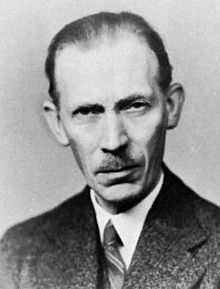Johannes Nicolaus Brønsted
Johannes Nicolaus Brønsted (born February 22, 1879 in Varde , Jutland ; † December 17, 1947 in Copenhagen ) was a Danish physical chemist who is particularly known for the acid-base theory he created .
Live and act
Brønsted began his studies as a chemical engineer in 1897 at the Polytechnic in Copenhagen with the degree in 1899 and then studied chemistry at the University of Copenhagen with the degree in 1902. In 1905 he became an assistant at the Chemical Institute. He received his doctorate in 1908 and in the same year he received the third chemistry chair for physical chemistry that had just been established at the university . At the same time he taught inorganic chemistry at the Polytechnic until 1930 . He specialized in physical chemistry and chemical thermodynamics , which, despite the rapid development of the subject in his time ( Wilhelm Ostwald , Svante Arrhenius , Walther Nernst ) had been neglected in Denmark. However, in the 19th century, Julius Thomsen in Copenhagen dealt with it, which Brønsted followed up on. This began with a series of works from 1904 and especially 13 monographs from 1906 to 1921 on chemical affinity , which, according to Thomsen, he linked with heat of reaction, but not investigated calorimetrically, but on the electromotive force of galvanic cells. The third of these works was also his dissertation. In some cases, he supported the theory put forward by Nernst in 1906. At that time, Sören Sörensen established the definition of pH in Denmark .
At the beginning of the twenties of the 20th century he worked with George de Hevesy on isotope separation by fractional distillation of mercury and chlorine and their atomic mass determination. He also determined experimentally the activity coefficients introduced by Gilbert Newton Lewis and found with La Mer their dependence on charge and ionic strength (which Peter Debye and Erich Hückel were theoretically investigating at the same time ). In 1922 he clarified the influence of the activity coefficients of solutions on reaction rates.
His proton theory about acids and bases , now known as Brønsted-Lowry, dates from 1923 (see acid-base concepts ). Brønsted and Martin Lowry had independently come to the same definition. The starting point of the theory was his investigation of the catalytic decomposition of nitramide with Pedersen (1922), where he recognized that substances also have a base-like effect if they do not form hydroxide ions.
In 1926 and 1927 Brønsted was a visiting professor in the USA and lectured at Yale University and Columbia University, among others . In the following years he carried out colloid chemistry studies and investigated the properties of high polymers.
From 1930 he became director of his own newly founded institute for physical chemistry in Copenhagen, where he also got his own laboratory. It was founded with international support, as although it attracted many foreign scientists and students to Copenhagen, the conditions were very cramped.
Brønsted was dissatisfied with the usual presentations of thermodynamics and developed his own formulation, which brought him into violent conflicts with physicists.
In 1947 he was elected to the Folketing for Venstre , but could no longer take up his mandate due to advancing illness.
Others
In some German textbooks the name is incorrectly spelled Brönsted , Brönstedt or Brønstedt .
Fonts (selection)
- Blanding affinities: binary systemers, Copenhagen 1908
- Grundrids of den fysiske kemi ( textbook for physical chemistry ), Copenhagen 1912, new edition 1936, 1943 (English translation London 1937)
- Some remarks on the concept of acids and bases, Recueil des travaux chimiques des Pays-Bas et de la Belgique, 42 (1923), 718–728
- with VK la Mer: The Activity Coefficients of Ions in Very Dilute Solutions , Journal of the American Chemical Society, 46 (1924), 555-573
- with K. Pedersen: The catalytic decomposition of nitramides and their physico-chemical significance, Zeitschrift fur physical chemistry, 108 (1924), 185-235
- Om syre- og basekatalyse (On Acid and Base Catalysis), Copenhagen 1926
- The Fundamental Principles of Energetics, Philosophical Magazine, 7th ser., 29 (1940), 449-470
- On the Concept of Heat, Kongelige Danske Videnskabernes Selskabs Skrifter, 19, no.8 (1941), 79 ff.
-
Principer og problemer i energetiken , Copenhagen 1946,
- English translation: Principles and problems in energetics , Interscience 1955
Honors (selection)
- 1928: Örsted Medal from the Danish Selskabet for naturlærens udbredelse
- 1929: Member of the American Academy of Arts and Sciences
- 1947: Honorary Doctorate from the University of London
- 1947: Member of the National Academy of Sciences
literature
- Stig Veibel: Brønsted, Johannes Nicolaus . In: Charles Coulston Gillispie (Ed.): Dictionary of Scientific Biography . tape 2 : Hans Berger - Christoph Buys Ballot . Charles Scribner's Sons, New York 1970, p. 498-499 .
- Winfried Pötsch u. a. Lexicon of important chemists , Harri Deutsch 1989
- JA Christiansen, obituary in: Oversigt Danske Videnskabernes Selskabs 1948–1949, pp. 57–79 (with list of publications)
- Dr. Karl Heinig (Hrsg.): Biographies of important chemists . 5th edition. People and Knowledge Volkseigener Verlag, Berlin 1983.
See also
Web links
- Literature by and about Johannes Nicolaus Brønsted in the catalog of the German National Library
Individual evidence
- ↑ JN Brønsted. The store Danske - Dansk Biografisk Leksikon , accessed on July 8, 2019.
- ↑ Whereby he based thermodynamics in the greatly expanded new edition on the teaching of Josiah Willard Gibbs instead of on Carnot cycles as in the 1st edition
| personal data | |
|---|---|
| SURNAME | Brønsted, Johannes Nicolaus |
| BRIEF DESCRIPTION | Danish chemist |
| DATE OF BIRTH | February 22, 1879 |
| PLACE OF BIRTH | Varde , Jutland |
| DATE OF DEATH | December 17, 1947 |
| Place of death | Copenhagen |
